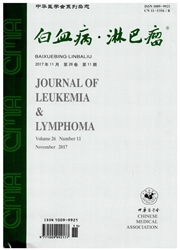

 中文摘要:
中文摘要:
目的应用白细胞淤滞分级评分(LGS)评价高白细胞急性髓系白血病(HAML)降白细胞的疗效。方法回顾性分析54例HAML患者临床资料,根据患者临床症状和LGS系统进行评分,分析LGS与患者白细胞淤滞症状和早期病死率的关系,并分析降白细胞治疗后LGS变化。结果54例HAML患者中M1 1例,M2 16例,M4 10例,M5 20例,未分型7例。LGS0分3例,LGS1分15例,LGS2分17例,LGS3分19例。LGS≤2分患者中自细胞淤滞所致的I型呼吸衰竭、中枢神经系统症状及早期病死的发生率均低于LGS3分的患者(P〈0.05)。降白细胞治疗后HAML患者LGS较治疗前改善(P〈0.0001)。其中降白细胞治疗过程中白细胞分离组LGS改善率高于未分离组(P=0.008)。37例患者接受诱导化疗,1个周期化疗后20例获得完全缓解,LGS≤2分患者完全缓解率与LGS3分者差异无统计学意义(P=0.703)。结论LGS能够反映HAML患者白细胞淤滞的程度,可以评价降白细胞治疗后白细胞淤滞改善情况,LGS高预示更高的早期病死率。白细胞分离术联合小剂量化疗较单纯小剂量化疗能显著降低LGS。
 英文摘要:
英文摘要:
Objective To evaluate the treatment efficacy of leukocyte reduction in hyperleukocytic acute myeloid leukemia (HAML) patients with leukostasis grading score (LGS). Methods The data of 54 HAML patients were analyzed retrospectively. The relationship between LGS and leukocyte stasis symptoms or early mortality was observed, and the impact of leukapheresis on LGS was analyzed. Results Among 54 patients with HAML, there were 1 case of M1, 16 cases of M2, 10 cases of M4, 20 cases of M5 and 7 cases of unclassified AML. Based on clinical symptoms and LGS system, 3 cases were LGS 0, 15 cases LGS 1, 17 cases LGS 2, and 19 cases LGS 3. In patients with LGS ~〈 2, the rates of type I respiratory failure, central nevers system (CNS) symptoms and early mortality caused by leukostasis were significantly lower than those in patients with LGS 3 (P 〈 0.05). The LGS of HAML patients was reduced by leukocyte reduction therapy (P 〈 0.000 1). The LGS of HAML patients treated by leukapheresis and low dose chemotherapy was improved significantly than that of patients treated without leukapheresis (P = 0.008). Among 37 cases receiving induction chemotherapy, 20 cases reached complete remission (CR) after the first cycle of induction chemotherapy. CR rate of patients with LGS ~〈 2 was no significantly different compared with that of patients with LGS 3 (P = 0.703). Conclusions LGS can be used to evaluate the degree and the improvement status of leukostasis after treatment in HAML patients. The early death often oceurres in patients with high LGS. Leukapheresis combined with low-dose chemotherapy can effectively improve the LGS of HAML patients.
 同期刊论文项目
同期刊论文项目
 同项目期刊论文
同项目期刊论文
 期刊信息
期刊信息
